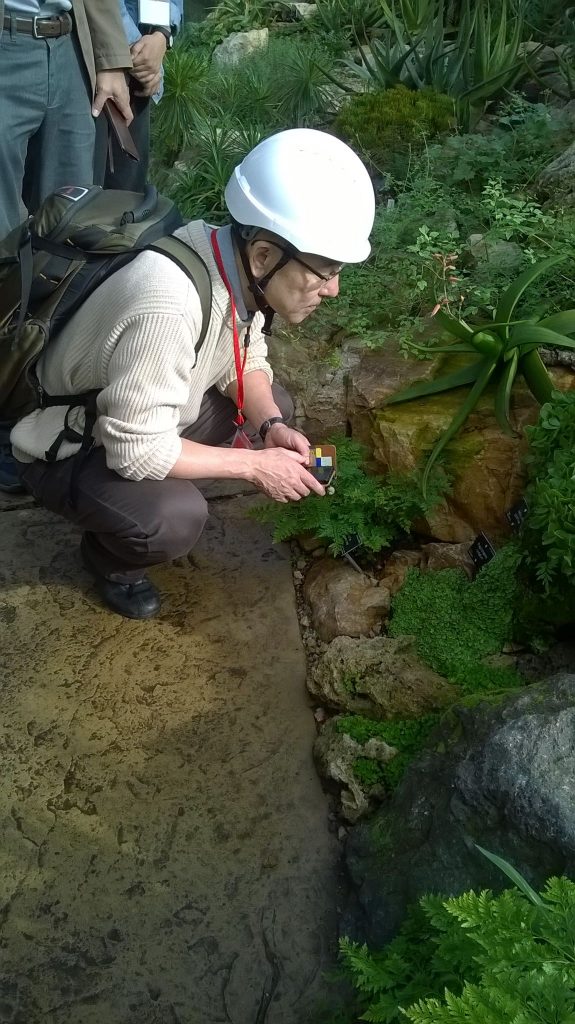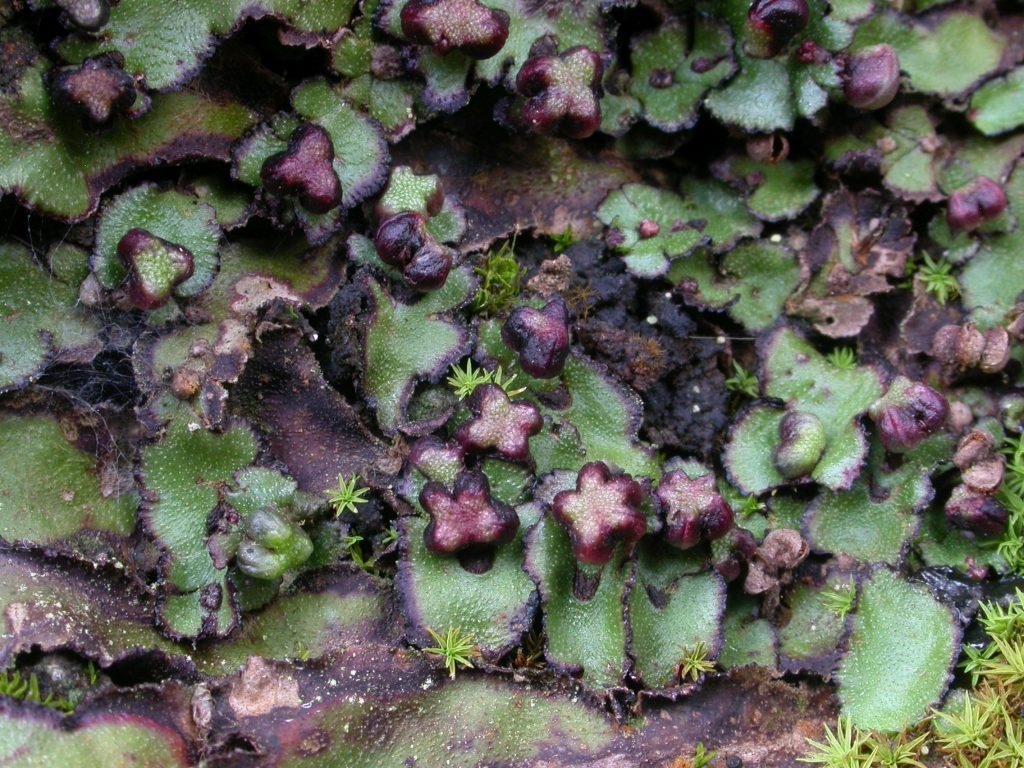Now that we have six wild-collected accessions of Plagiochasma currently growing on public display in the RBGE Arid House, from China, the US (Texas) and Saudi Arabia, I’ve started to pull together some of the published information about the species, thinking about public interpretation. This Botanics Stories post, therefore, does not contain any new information about the plants, but is a compilation of published snippets from the references given at the end (not all of which are open access). I have generated this as a way of keeping my own notes in a semblance of order, and intend to add to it when I come across more relevant references.

Prof Takayuki Kohchi examining a wild-collected accession of Plagiochasma from Yunnan, China growing in the RBGE Arid House
Genus Plagiochasma Lehm. et Lindenb., Family Aytoniaceae. Usually calcarious substrates. Mainly warm-temperate and tropical regions.
“Easily separated from other genera of Aytoniaceae by the 1) leathery and strongly xeromorphic thallus, 2) absence of rhizoid furrow in the archegoniophore stalks, 3) subspherical archegonial head with bivalved involucres, and 4) antheridia in cushions bounded by scales, on dorsal or at base of apical adventitious branches” (Chantanaorrapint & Sridith 2014, p. 128).
Subgenus Plagiochasma – fewer, larger epidermal pores, surrounded by several rings of cells; Smooth or finely granulose epidermis; often papillae on ventral scales; appendages with differentiated or toothed margins.
Plagiochasma appendiculatum Lehm. et Lindenb. “meridional de l’Himalaya la limite au N … chaud à hiver sec, tropical à saison sèche, steppique, tempéré humide à été chaud” (Bischler 1979, p. 32); “en bordure de rivières ou de cascades, ou dans des ravins. Il colonise les fentes des rochers calcaires ou les interstices des murs, en situation exposée ou ombragée” (Bischler 1978, p. 234). AFRICA: Ethiopia, Kenya, Rhodesia, Tanzania, Socotra, Yemen, ASIA: Afghanistan, Burma, Thailand, Celebes, China, Taiwan, India, Kashmir, Nepal, Pakistan, Sikkim, Vietnam. EUROPE: Spain (Mallorca). Also reported from the Arabian peninsula. “une espèce assez homogène, toujours facilement reconnaissable à la forme très particulière de l’appendice de ses écailles” (Bischler 1978, p. 233). “easily separated from other Asian species by having ventral scales with orbicular to broadly ovate appendages which are constricted at base” (Chantanaorrapint & Sridith 2014, p. 129).
Plagiochasma argentinicum Bischl.: Dry calcarious rocks. AMERICA: Argentina. Only collected twice. Is “easily recognized by the finely granulose epidermis and by the ventral scales being bordered by sinuose cells and having 2-4 narrow appendages” (Bischler-Causse et al. 2005, p. 190).
Plagiochasma beccarianum Steph.: “les fentes des rochers (granites, schistes lustrés) temporairement humides et ombragés” (Bischler 1978, p. 263). Rare. AFRICA: Ethiopia, Namidia, Socotra, Tanzania, Zambia. Also reported from Arabian Peninsula. “se distingue des autres espèces africaines du sous-genre principalement par ses éscailles, munies d’appendices très étroits, acuminés et irrégulièrement dentés. Ses caractéristiques le rapprochent de P. eximium” (Bischler 1978, p. 262). Is “regarded as quite a heterogeneous species, but so closely resembling P. eximium that the two species are often difficult to distinguish when sterile (Bischler 1978). In the few southern African specimens of P. beccarianum available for study, it appears that the fresh thalli are a clear green dorsally, not yellow-green, and the underside of the wings as well as the scales are deep purple and not dark red as in P. eximium. The two or three scale appendages of P. beccarianum are ± acuminate or narrowly triangular and not constricted at the base; their margins are irregularly toothed” (Perold 1995, p. 28). Considered to be a species complex by Bischler (1978).
Plagiochasma cordatum Lehm. et Lindenb. “chaud à hiver sec, tempéré humide à été chaud, steppique… conolise les fentes ou les surplombs de rochers granitique ou calcaires, généralement ombragés” (Bischler 1979, p. 53). ASIA: Afghanistan, Bhutan, China, Taiwan, Hawaii(?), India, Nepal, Thailand. “similar to P. pterospermum C.Massal. in having 2-3 narrowly triangular appendages of the ventral scales. The latter, however, is easily separated by smaller thallus and reticulation of spores” (Chantanaorrapint & Sridith 2014, p. 131).
Plagiochasma crenulatum Gottsch.: Rock & wall crevices, dry warm areas. AMERICA: Southern US, Mexico, Guatemala, Honduras, Costa Rica. Is “a polyploid species… distinguished from other neotropical species by the wide, roudned or ovate appendages of the ventral scales” (Bischler-Causse et al. 2005, p. 193).
Plagiochasma cuneatum A. Evans. Dry, warm areas AMERICA: US (Texas), Mexico, Guatemala to Haiti. “easily distinguished by the finely granulose epidermis and by its dark purplish ventral scales with long, aculmiante, hyaline appendages” (Bischler-Causse et al. 2005, p. 193). “A remarkable feature of P. cuneatum, which will at once distinguish the species from all the other American representatives of the genus, is the division of the fertile thallus into a series of joints” (Evans 1932, p. 630).
Plagiochasma eximium (Schiffn. in Steph.) Steph.: “des zones subtropicales N aux zones tempérées S… récolté en bordure de rivières ou de cascades, ou dans des grottes” (Bischler 1978, p. 253). Widespread in Africa – AFRICA: South Africa, Cameroun, Cape Verde, Djibouti, Ethiopia, Guinea, Kenya, Malawi, Oman, Uganda, Reunion, Sierra Leone, Socotra, Tanzania, Yemen, Zaire. “ressemble fortemente à P. beccarianum et les deux espèces sont souvent difficiles à distinguer à l’état stérile” (Bischler 1978, p. 253). It “can be distinguished by its robust, yellow-green thalli with large, deep pink to wine-red ventral scales narrowed above into (1 )2 or 3 tapering appendages which are only a little constricted or pleated at the base. Ventrally the flanks are wrinkled and deep red, not dark purple” (Perold 1995, p. 27).
Plagiochasma intermedium Lindenb. & Gottsche: Mainly neotropical, warm dry areas. AMERICA: US, Mexico, Guatemala, Costa Rica, Venezuela, Peru(?), Argentina. “the sole neotropical species having elators without helical bands. Additionially, shape and structure of the appendages of the ventral scales separate the species from all other neotropical representatives of the genus” (Bischler-Causse et al. 2005, p. 195).
Plagiochasma jamaicense (Haynes) A. Evans. Neotropical. AMERICA: Mexico & Jamaica. “related to P. wrightii and can be distinguished…by the larger thallus, finely granulose epidermis, longer epidermal cells, and smaller epidermal pores, less raised above the thallus surface… the appendages of the scales are smaller and light red or purplish in color” (Bischler-Causse et al. 2005, p. 195-197).
Plagiochasma japonicum (Steph.) Mass. ASIA: Bhutan, China, Korea, Hawaii, India, Japan, Philippines “une espèce assez polymorphe en ce qui concerne l’aspect de ses thalles (articulés ou non, à tissu d’assimilation de densité très variable) et ses scailles (dimencion et forme des appendices)” (Bischler 1979, p. 41).
Plagiochasma landii A. Evans. Uncommon New World species; relatively dry rocky areas. AMERICA: Southern US, Mexico, Guatemala, Costa Rica. Contains “considerable variation” in morphological characters. Closest to P. cuneatum & P. argentinicum, but separated from them by a smooth epidermis (Bischler-Causse et al. 2005, p. 198).
Plagiochasma microcephalum (Steph.) Steph.: “desertique, steppique, chaud à hiver sec, tropical à saison sèche” (Bischler 1979, p. 38); “equally well adapted to dry or to damp habitats. It grows in dry river beds between limestone boulders or on granite hills or on damp stream banks” (Perold 1995, p. 23). AFRICA: South Africa, Angola, Ethiopoia, Madagascar, Namibia, Uganda, Tanzania, Tunisia, Yemen, ASIA: India. “une espèce bien distincte de tous les autres représentants du subg. Plagiochasma en Afrique, sans affinité marquée pour aucun d’eux. Il se reconnaît facilement à la forme et à la structure des appendices de ses écailles” (Bischler 1978, p. 241).
var. microcephalum: the same distribution as the species, except not in Tunisia; “colonise les fentes des rochers calcaires ou schisteux, humides ou ruisselants, généralement ombragés. Son substrat peut être argileux ou sableux” (Bischler 1978, p. 244). “It can be distinguished by the green colour of the fresh thallus and by the generally large, broadly ovate or triangular scale appendages which haveone or two rows of smaller cells along the margin” (Perold 1995, p. 21).
var. tunesicum Bischl. AFRICA: Tunisia. “les appendices ont des margins moins nettement differenciées, ils sont hyalins au sommet mais rouges à partir du centre, fortement rétrécis el plissés à la base, leur largeur maximum se situant nettement au centre” (Bischler 1979, p. 38).
Plagiochasma muenchianum Steph. AMERICA: Mexico. Known from a single man-made locality (on a mortar wall in San Cristobal, Chiapas). Related to P. wrightii (which differs in having a narrower thallus, finely granulose epidermis and smaller pores) and P. jamaicense (which differs in having smaller, narrower toothless scale appandages, and has frequent apical adventitious thallus branches) (Bischler-Causse et al. 2005, p. 198).
Plagiochasma pterospermum Mass. “conolise les fentes des rochers ou les interstices des murs (calcieres, grès, serpentines, etc), exposés ou ombragés” (Bischler 1979, p. 61). ASIA: China, Korea, Taiwan, India, Japan, Nepal, Pakistan, Philippines.
Plagiochasma wrightii Sull. New World species; damp sandy soil in rock crevices, dry but warm areas. AMERICA: Southern US, Mexico. Characterised by “single, hyaline, acute appendages of the scales. Plagiochasma muenchianum and P. jamaicense have similar appendages but are separated by the smooth epidermis and by the wider thalli” (Bischler-Causse et al. 2005, p. 200).
Subgenus Micropylum Bischl. – more, smaller epidermal pores, surrounded by single ring of cells; irregularly covered epidermis; no papillae on ventral scales; appendages with undifferentiated entire margins. A single widespread species.
Plagiochasma rupestre (J.R. & G.Forst.) Steph. Pantropical. MEDITERRANEAN: Acores, Albania, Algeria, Baleares, Canaries, Cyprus, Corsica, Crete, Egypt, Spain, France, Grece, Italy, Madiera, Morocco, Montecristo, Portugal, Sardinia, Sicily, Tunisia, Turkey, Yugoslavia; AFRICA: South Africa, Angola, Ascension, Cape Verde, Djibouti, Ethiopia, Kenya, Lesotho, Maurice, Namibia, Uganda, Reunion, Rhodesia, St Helene, Soudan, Tanzania, Chad, Yemen; AMERICA: Southern US, Mexico, warm-temperate south America; ASIA; OCEANIA
var. rupestre: warm regions of the world – Europe, Mediterranean, Macaronesia, S.W. Asia, India, tropical & S. Africa, Mascarenes, Australia, New Zealand, Oceanea. “easily identified by its dull, velvety and glaucous thalli with simple, very inconspicuous pores and by its reddish pink or purple scales, with ovate-lanceolate or acuminate appendages, the margins of which are entire” (Perold 1995, p. 17).
var. volkii Bischl.: Zimbabwe, Lesotho, Namibia, South Africa, the Neotropics (Peru, Bolivia, Argentina). Has “longer, acuminate, hyaline appendages of the ventral scales and slightly larger spore dimensions” than var. rupsetre (Perold 1995, p. 15).
REFERENCES
Alexander W. Evans, 1915. The genus Plagiochasma and its North American species. Bulletin of the Torrey botanical club 42: 259-308.
Alexander W. Evans. 1932. A New Plagiochasma from Texas. American Journal of Botany 19(7): 627-631.
Helene Bischler, 1978. Plagiochasma Lehm. et Lindenb. II. Les taxa européens et africains. Revue bryologique et lichenologique 44: 223–300.
Helene Bischler, 1979. Plagiochasma Lehm. et Lindenb. III. Les taxa d’ Asie et Océanie. Journal of the Hattori botanical laboratory 45: 25–79.
R. Baudoin & Helene Bischler, 1979. Analyse statistique du genre Plagiochasma Lehm. et Lindenb. etude du sous-genre Plagiochasma en Asie et en Oceanie. Journal of the Hattori Botanical Laboratory 45: 81-91.
Sarie M. Perold, 1995. Studies in the Marchantiales (Hepaticae) from southern Africa. 8. The genus Plagiochasma (Aytoniaceae: Aytonioideae) and six local taxa. Bothalia: African Biodiversity & Conservation 25(1): 13-29.
Bischler-Causse H., Robbert S. Gradstein, Jovet-Ast S., David G. Long & Noris Salazar Allen, 2005. Marchantiidae. Flora Neotropic monograph 97: 1–262.
Rosa M. Cros, Llorenc Saez & Josep Antonio Rossello, 2005. Plagiochasma appendiculatum Lehm. & Lindenb. (Marchantiales, Aytoniaceae), a species new to the European bryophyte flora. Journal of Bryology 27: 3–6
Jorge R. FloresGuillermo M. Suárez, 2015. Plagiochasma intermedium Lindenb. & Gottsche (Aytoniaceae, Marchantiophyta), the third species of Plagiochasma for southern South America. Cryptogamie Bryologie 36(1): 75-80.

